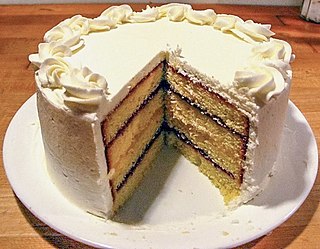
Cake is a flour confection made from flour, sugar, and other ingredients and is usually baked. In their oldest forms, cakes were modifications of bread, but cakes now cover a wide range of preparations that can be simple or elaborate and which share features with desserts such as pastries, meringues, custards, and pies.

A chocolate chip cookie is a drop cookie that features chocolate chips or chocolate morsels as its distinguishing ingredient. Chocolate chip cookies are claimed to have originated in the United States in 1938, when Ruth Graves Wakefield chopped up a Nestlé semi-sweet chocolate bar and added the chopped chocolate to a cookie recipe; however, historical recipes for grated or chopped chocolate cookies exist prior to 1938 by various other authors.

A scone is a traditional British baked good, popular in the United Kingdom and Ireland. It is usually made of either wheat flour or oatmeal, with baking powder as a leavening agent, and baked on sheet pans. A scone is often slightly sweetened and occasionally glazed with egg wash. The scone is a basic component of the cream tea. It differs from teacakes and other types of sweets that are made with yeast. Scones were chosen as the Republic of Ireland representative for Café Europe during the Austrian presidency of the European Union in 2006, while the United Kingdom chose shortbread.
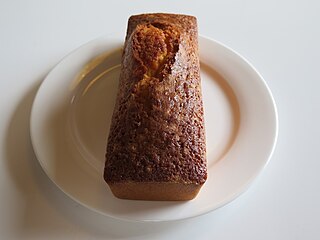
Pound cake is a type of cake traditionally made with a pound of each of four ingredients: flour, butter, eggs, and sugar. Pound cakes are generally baked in either a loaf pan or a Bundt mold. They are sometimes served either dusted with powdered sugar, lightly glazed, or with a coat of icing.

Soda bread is a variety of quick bread made in many cuisines in which sodium bicarbonate is used as a leavening agent instead of yeast. The basic ingredients of soda bread are flour, baking soda, salt, and buttermilk. The buttermilk contains lactic acid, which reacts with the baking soda to form bubbles of carbon dioxide. Other ingredients can be added, such as butter, egg, raisins, or nuts. Quick breads can be prepared quickly and reliably, without requiring the time and labor needed for kneaded yeast breads.
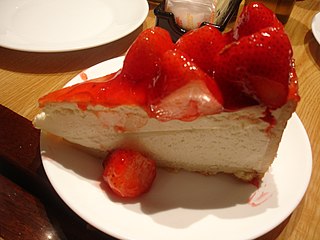
Cheesecake is a dessert made with a soft fresh cheese, eggs, and sugar. It may have a crust or base made from crushed cookies, graham crackers, pastry, or sometimes sponge cake. Cheesecake may be baked or unbaked, and is usually served chilled.
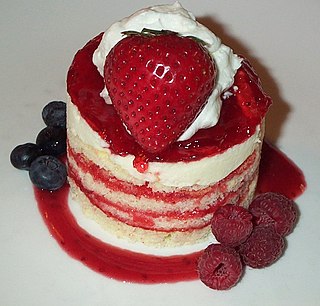
Shortcake generally refers to a dessert with a crumbly scone-like texture. There are multiple variations of shortcake, most of which are served with fruit and cream. One of the most popular is strawberry shortcake, which is typically served with whipped cream. Other variations common in the UK are blackberry and clotted cream shortcake and lemon berry shortcake, which is served with lemon curd in place of cream.
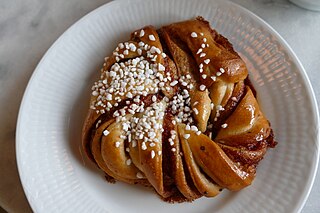
A cinnamon roll is a sweet roll commonly served in Northern Europe and North America. In Sweden it is called kanelbulle, in Denmark it is known as kanelsnegl, in Norway it is known as kanelbolle, skillingsbolle, kanelsnurr, or kanel i svingene, in Finland it is known as korvapuusti, in Iceland it is known as kanilsnúður, and in Estonia it is known as kaneelirull. In Austria and Germany, it is called Zimtschnecke. In Slovakia and the Czech Republic, it is called škoricové slimáky/skořicoví šneci.

A rusk is a hard, dry biscuit or a twice-baked bread. It is sometimes used as a teether for babies. In some cultures, rusk is made of cake, rather than bread: this is sometimes referred to as cake rusk. In the UK, the name also refers to a wheat-based food additive.

Boxty is a traditional Irish potato pancake. The dish is mostly associated with the north midlands, north Connacht and southern Ulster, in particular the counties of Leitrim, Mayo, Sligo, Fermanagh, Longford, and Cavan. There are many recipes but all contain finely grated, raw potatoes and all are served fried.

A fat rascal, closely related to the historical turf cake, is a type of cake, similar to a scone or rock cake in both taste and ingredients. It originated in Yorkshire at least as early as the 19th century.

Hot milk cake is a butter sponge cake from American cuisine. It can be made as a sheet cake or a layer cake, or baked in a tube pan. The hot milk and butter give the cake a distinctive fine-grained texture, similar to pound cake.
Hasty pudding is a pudding or porridge of grains cooked in milk or water. In the United States, it often refers specifically to a version made primarily with ground ("Indian") corn, and it is mentioned in the lyrics of "Yankee Doodle", a traditional American song of the eighteenth century.

A teacake in the UK is generally a light yeast-based sweet bun containing dried fruit, typically served toasted and buttered. In the U.S. teacakes can be cookies or small cakes. In Sweden, they are soft, round, flat wheat breads made with milk and a little sugar, and used to make buttered ham or cheese sandwiches. In India and Australia, a teacake is more like a butter cake. Tea refers to the popular beverage to which these baked goods are an accompaniment.
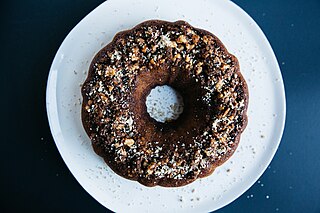
Coffee cake or coffeecake is a sweet bread common in the United States, so called because it is typically served with coffee. Leavenings can include yeast, baking soda, or baking powder. The modern dish typically contains no coffee. Outside the US, the term is generally understood to mean a cake flavored with coffee.
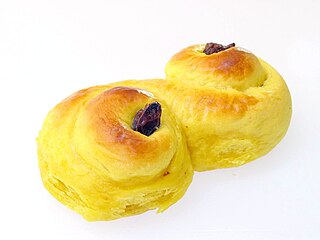
A saffron bun, Cornishtea treat bun or revel bun, is a rich, spiced yeast-leavened sweet bun that is flavoured with saffron and contains dried fruit including currants and raisins similar to a teacake. The main ingredients are plain flour, butter, yeast, caster sugar, currants and sultanas. Larger versions baked in a loaf tin are known as saffron cake.

In the United States, a biscuit is a variety of baked bread with a firm, dry exterior and a soft, crumbly interior. In Canada it sometimes also refers to this or a traditional European biscuit. It is made with baking powder as a leavening agent rather than yeast, and at times is called a baking powder biscuit to differentiate it from other types. Like other forms of bread, a biscuit is often served with butter or other condiments, flavored with other ingredients, or combined with other types of food to make sandwiches or other dishes.

Sponge cake is a light cake made with eggs, flour and sugar, sometimes leavened with baking powder. Some sponge cakes do not contain egg yolks, like angel food cake, but most of them do. Sponge cakes, leavened with beaten eggs, originated during the Renaissance, possibly in Spain. The sponge cake is thought to be one of the first non-yeasted cakes, and the earliest attested sponge cake recipe in English is found in a book by the English poet Gervase Markham, The English Huswife, Containing the Inward and Outward Virtues Which Ought to Be in a Complete Woman (1615). Still, the cake was much more like a cracker: thin and crispy. Sponge cakes became the cake recognised today when bakers started using beaten eggs as a rising agent in the mid-18th century. The Victorian creation of baking powder by English food manufacturer Alfred Bird in 1843 allowed the addition of butter to the traditional sponge recipe, resulting in the creation of the Victoria sponge. Cakes are available in many flavours and have many recipes as well. Sponge cakes have become snack cakes via the Twinkie.

A singing hinny or singin' hinny is a type of bannock, griddle cake or scone, made in the north of England, especially Northumberland and the coal-mining areas of the North East. In Scotland, they are known as fatty cutties.

Plum cake refers to a wide range of cakes usually made with dried fruits such as currants, raisins, sultanas, or prunes, and also sometimes with fresh fruits. There is a wide range of popular plum cakes and puddings. Since the meaning of the word "plum" has changed over time, many items referred to as plum cakes and popular in England since at least the eighteenth century have now become known as fruitcake. The English variety of plum cake also exists on the European mainland, but may vary in ingredients and consistency. British colonists and missionaries brought the dried fruit variety of cake with them, for example, in British India where it was served around the time of the Christmas holiday season. In America's Thirteen Colonies, where it became associated with elections, one version came to be called election cake.



















